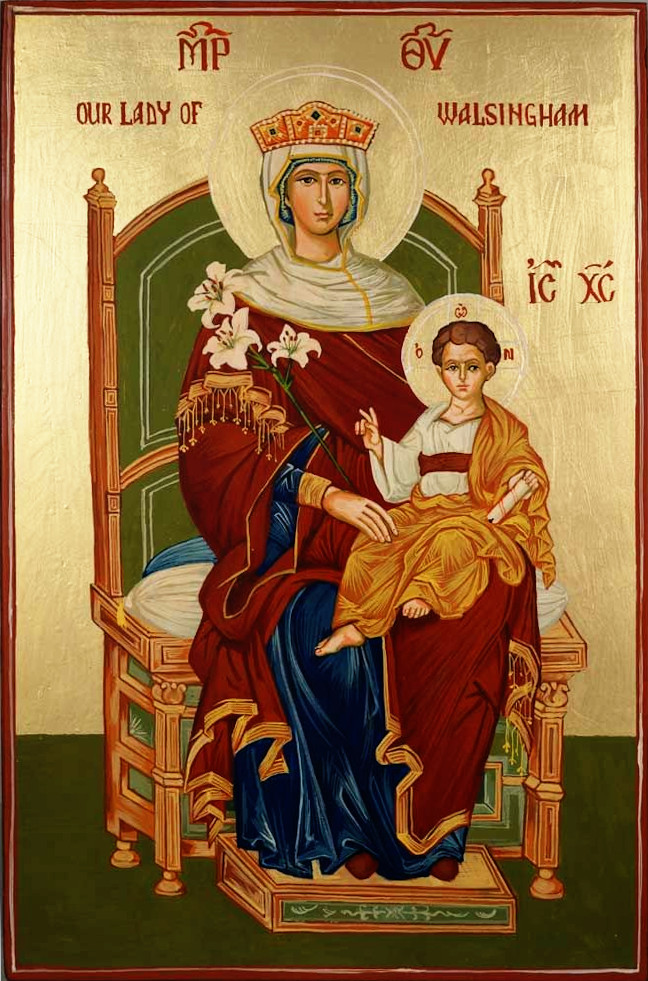02 June 2019
Holy Hierarch Oda of Canterbury
In the Orthodox Church today we commemorate another holy Archbishop of Canterbury, Auði or Oda ‘the Good’ or, in Old English, ‘Oda se Góda’. Sadly, the rhyming cognomen – which was coined by Saint Dúnstán according to the tradition – hasn’t carried down to modern times. Archbishop Saint Oda was also known by the betimes-deserved epithet ‘the Severe’.
He was born around the year 870, which means his father was all but certainly part of the Great Heathen Here led by Ívarr the Boneless and Ubba; Oda was born in East Anglia quite shortly after their landing. In what seems to have been an act of teenage rebellion, the young Oda was drawn to Christianity and spent a good deal of time in church – much to the consternation of his heathen father, who tried to hinder him from going, and even disowned him when he continued to visit the church. Oda’s longing for the Christian life was, however, wholly in earnest, and he ended up being baptised and adopted into the household of the Christian landowner Æþelhelm (who may have been a mother’s-side kinsman) who encouraged young Oda in his Churchly career. After Oda was ordained to the priesthood, he accompanied Æþelhelm on a pilgrimage to Rome, on which his adoptive father fell ill. Oda was able to cure Æþelhelm’s illness with a cup of wine which he had blessed.
The early part of Oda’s tenure as a bishop is somewhat unclear. According to William of Malmesbury he was consecrated as Bishop of Wilton in 920 (or 923); the slightly more proximate (and, according to the Catholic Encyclopædia, plausible) historian Éadmær of Canterbury has it that he was Bishop of Sherborne in 925. What is clear, though, is that he was certainly Bishop of Ramsbury by 927. He accompanied the court of Æþelstán King, and – according to one tale – was present at the Battle of Brunanburh which saw Æþelstán and the English nation pitted against an invading alliance of Vikings, Scots and Irishmen from the kingdoms of Dublin, Scotland and Alt Clut. During the battle, Æþelstán’s sword fell from its scabbard and was lost. By a wonder of God, Oda found the sword in his own hand, which he gave to the king, thus sparing him from a grim fate. This tale may or may not be pious exaggeration, but what is fact and even more significant, is that the half-Danish Oda managed to secure a truce between the Viking prince Óleifr Gúðriðarson of Dublin – who had fought against the English at Brunanburh – and Æþelstán’s half-brother and successor Éadmund Æþeling.
Éadmund Æþeling wished to promote Saint Oda to the Archbishopric of Canterbury after the repose of Archbishop Wulfhelm in 941, but Oda refused several times. He pointed out that the last Archbishops of Canterbury had all been monks, and he was not. But as Éadmund King insisted, Oda went to be tonsured a Benedictine at Abbaye Fleury and then meekly accepted the appointment. (This is the same Abbey to which he recommended his dear nephew Saint Osweald of Worcester to study and to take the Benedictine cowl.) Among the very first things that Saint Oda did upon his appointment was to order much-needed repairs to Canterbury Cathedral, and historical records relate that for three years afterward there were no storms or wind within the cathedral pale.
Oda earned his nickname ‘the Severe’, not because he was particularly tyrannical as an archbishop or as a monk, but instead because he used his archepiscopal amvon to insist firmly to the nobles that they abide to a strict rule of justice and order. To this end in particular, he assisted Éadmund in codifying a law-book for his kingdom. Oda insisted that England’s wealthy and high-born abide in regular marriages rather than keeping mistresses, uphold the cause of the powerless in courts of law, fast, give alms and pay tithes to the church. He also wrote an introduction to the Vita of the saintly (but controversial in his own lifetime) Northumbrian bishop of York, Wilfrið. He remained on good terms with the subsequent king Éadred, and struck up a strong and lasting friendship with Éadred’s trusted advisor Saint Dúnstán, who was then Abbot of Glastonbury Abbey. During Éadred’s reign, Oda – though a Benedictine himself only in a technical sense – became firmly attached to and a steadfast supporter of the order’s reform movement in England headed by Saint Dúnstán and sponsored by Éadred. It was known that Oda favoured Dúnstán to succeed him as Archbishop of Canterbury.
Oda was responsible for the coronation of the generous but ill-fated Éadwig Eallfæger, who spent the day of his feast dallying with his unfortunately-consanguine sweetheart Ælfgifu and her mother. Oda was a firm and implacable foe of this particular match: not only because of the incident at the coronation feast, but because Ælfgifu and Éadwig were second cousins – a match forbidden under the Church canons. He ultimately succeeded in having the marriage annulled, though Éadwig would die in murky circumstances some short while later.
Oda also crowned Éadwig’s successor Éadgár ‘the Frithsome’, whose rule in England was much more stable. However, Oda himself would not live much longer. Sensing his death nearing, he sent for his nephew Saint Osweald, but the younger churchman didn’t make it in time. Archbishop Oda reposed in the Lord and gained the heavenly kingdom on the second of June, 959.
Oda was succeeded, sadly, not at once by Dúnstán but instead by Ælfsige, who died of illness en route to Rome on a pass through the Alps. Byrhthelm was then sent, but he too died early – and Dúnstán then succeeded to the archbishopric. Dúnstán had a particular devotion to Saint Oda, and would never pass by his tomb without stopping first to pray there. Oda’s tomb became known for the wonders and healings wrought there. Holy Father Oda, saintly archbishop, upholder of God’s justice and rectifier of monasteries, pray to Christ our God for our salvation!
Subscribe to:
Post Comments (Atom)














No comments:
Post a Comment